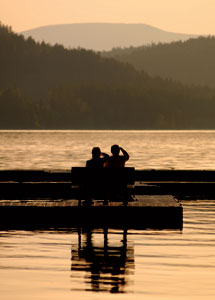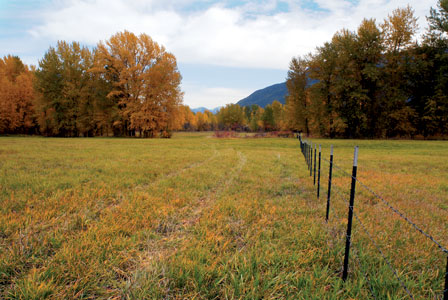Several city council seats are up for grabs in Kalispell, Whitefish and Columbia Falls in November. Sure, city council elections aren’t nearly as sexy as campaigns for president, Congress, or even the state Legislature. There’s little in the way of debate, expensive suits, flashy posters or vaguely inspirational campaign theme songs. But Election Day is a chance for voters to exercise the power they possess. It’s a chance to decide whether your city council representative shares your view of the future.
Kalispell, Whitefish and Columbia Falls all share common issues like grappling with growth, improving transportation, and ensuring water quality while maintaining city services. But there are ways in which the needs and expectations of these cities’ populations differ – and the views of those cities’ elected officials differ accordingly. With that in mind, the Beacon interviewed a handful of current mayors and city council members to get an overview of the political issues facing the three cities in coming months and coming years.
WHITEFISH
 |
|
Whitefish: a town with two identities |
The Whitefish City Council has been lambasted in recent months on a series of controversial issues: a feud with County Commissioner Gary Hall; its hesitancy to approve a renovation and expansion of Safeway supermarket; attempts to adopt a growth policy; and court cases disputing the infamous Critical Areas Ordinance, which dictates, among other things, the degree of slope on land that can be developed.
The criticism has rolled in from county officials, newspaper editorials and the public, stymieing the work of council members who are unrepentant and say they are simply trying to maintain Whitefish’s character in the face of development.
“We do want to have a quality community,” said Mayor Cris Coughlin, who took over after former mayor Andy Feury stepped down earlier this year and is running next month. “That’s directly responsible for the citizens that live here.”
Coughlin defended the work of the council and said one of the biggest challenges Whitefish faces is balancing its two identities as the affluent, resort town it has grown into – while keeping it a place with a downtown hardware store where teachers, firefighters and police officers can afford to live, now and in the future.
“If we don’t take a firm stance now, we’re going to get smacked in the face in about 10 years,” Coughlin said. “When you don’t have these members of your community, living in your community, you have a problem.”
In a town where many second homes sit vacant for all but three months of the year, the irony of an affordable housing shortage is not lost on Coughlin.
“A lot of resort communities are struggling with the fact that they have become ‘Second Homeowner Land’; they’re filled with houses but they’re not filled with people,” she said. “You lose a whole segment of your town, that’s what really scares me the most.”
Compounding that problem is the question of what happens when and if certain downtown businesses, like barbershops and the hardware store leave. “If that sells, it is probably not going to reopen as a hardware store,” she said. Who can afford to move in, and does Whitefish need another high-end specialty store to fill that space? Coughlin looks to other resort towns in the Rocky Mountain West like Jackson, Wyo., or Aspen, Colo., which have gone so far as to subsidize certain core local businesses to keep them in place. “We need to look at that long before it ever gets to that point,” she added.
Like Kalispell and Columbia Falls, Whitefish needs to improve transportation infrastructure, but the viaduct over railroad tracks joining the north and south parts of town presents a unique set of problems. Traffic studies have shown Whitefish needs a better east-west connection, and another bridge joining the north part of the town to the south. “That won’t be cheap,” Coughlin said.
Fellow council member Shirley Jacobson, in the midst of her final term, agrees with Coughlin on much of the issues facing Whitefish, but despairs that public discourse there has reached such a low point over contentious issues of late, it’s growing increasingly difficult for council to accomplish anything at all.
“When you have more and more people moving in, you have to put your foot down, you have to take a stand,” Jacobson said. “We’re trying to preserve our community here and it’s really getting to be hard to do that.”
“The contentiousness here is just awful,” Jacobson added. “Just awful.”
COLUMBIA FALLS
 |
|
Columbia Falls: preserving open space. |
The politics are considerably more sedate, however, a few miles to the east, where Columbia Falls has three council seats open with the three incumbents running unopposed. Once an industrial hub for timber and aluminum production, Columbia Falls has recast itself as a gateway community to Glacier National Park. While it retains its working class roots with relative success, C-Falls, like Kalispell and Whitefish, is spreading. Its central issue in coming years is likely to be how it develops along – and across – the Flathead River.
Mayor Jolie Fish cast the deciding vote in August to purchase 20 acres of land at the edge of the city with 900 feet of river frontage.
“I did think it was a rare opportunity,” Fish said. “It was a very tough decision.”
The city bought the land with money from the sale of property to the north. But several council members objected to buying the parkland, saying road improvements should take priority over any other expenditure. “You can never satisfy everyone,” Fish added, noting that some of the money from the land sale did go to road improvements as well. “I get a lot of positive feedback on that vote.”
Columbia Falls officials acknowledge that the city limits are eventually going to expand across the river, raising complicated and expensive water and sewer problems. Some subdivisions across the river have been turned down already, partly due to that reason. “I think the river’s not going to stop us for long in the future,” Fish said.
A more immediate issue is what C-Falls will look like when currently approved lots are developed. While he couldn’t say how many lots exist, council member Doug Karper acknowledged that there are many.
“Just about every lot in current city limits is platted,” he said. “There’s no room to be had in the city limits.”
The issues Columbia Falls faces are the same as the other two cities, just on a smaller scale. The city has road dust problems up the North Fork, but its relationship with the county on such issues is downright amiable compared to Whitefish. Its city staff is tiny; the Police Department has one detective and cops frequently leave for better paying jobs elsewhere.
“We end up being a training ground for officers who go on to Kalispell, Whitefish and the Sheriff’s Department,” Fish said. The city also recently approved a multi-million dollar upgrade to its wastewater treatment plant.
Fish and Karper, like most city officials interviewed, have noticed a slowdown in the development proposals, and Fish is pleased that development seems to be quieting down a bit.
“I think that’s really positive,” she said. “It gives you a chance to regroup and prepare for the next onslaught.”
KALISPELL
Duane Larson, one of two sitting city council members being challenged for his seat, also believes the recent, slight downturn of development proposals is a positive thing.
“Right now, we have, in the city limits of Kalispell, in excess of 4,000 lots that have been approved but not to the point that we can build on them yet,” he said. “I think we’re fast approaching the point where we’re worried about infill.”
Larson, Ward Four’s representative, emphasizes that he is not anti-growth, but would like to see the city lean toward approving less subdivisions that are like remote islands of housing that the city must reach out to with miles of water and sewer lines. Instead, he thinks it’s time to begin to fill in some of the space between Kalispell and its outer boundaries with some higher-density developments.
“That’s probably not a popular position on the city council,” he said. “I’ve got a lot of convincing to do before the council reaches that decision.”
Larson’s colleague Randy Kenyon, currently being challenged for Ward Three, agrees that – after a decade of explosive residential and commercial development – it might be time for the city to catch its breath and look around.
“We really don’t know when it’s all going to end and I’m not sure that’s a direction to head,” Kenyon said. “We, as a group, probably need to come to a kind of consensus and figure out how far we are willing to go and how far we can afford to go.”
“This uncontrolled, infinite growth may not work,” Kenyon added. Both Larson and Kenyon acknowledge that they probably feel more strongly about infill than many fellow council members.
The issues facing the Flathead’s largest city are myriad, with the political tone typically congenial. A shortage of affordable housing, a need for more traffic corridors, road dust, commercial sprawl, water quality and the constant game of catch-up to provide services to new residents: Kalispell’s hurdles mirror Whitefish and Columbia Falls on a larger scale.
Kalispell has more space to allow the proliferation of box stores in its northern end. While a Kohl’s department store is on the way, the only other major commercial development heading for the city is James “Bucky” Wolford’s Glacier Town Center, a project 485 acres in size, composed of commercial, office and residential space that would roughly double the size of north Kalispell’s commercial district.
Kenyon said Wolford’s project, if approved, is likely to mark the end of the city’s rampant commercial growth.
“We haven’t really seriously talked about when we’ve reached the saturation point of commercial (development),” Kenyon said. “That’s kind of coming to an end.”
In the meantime, downtown and the Kalispell Center Mall continue to ride the cusp of relevance with restaurants and high-end clothing boutiques alongside some vacant storefronts.
“Are there enough specialty shops to support downtown?” Kenyon said. “Boy, that’s a tough one.”
Officials for all three cities interviewed said they would like to see greater public involvement in the growth and direction of the cities and speculated that low levels of citizen involvement and low turnout at meetings might mean people are pleased with the work of the councils. Acknowledging that substantial issues loom, Kenyon noted that many council members and the mayor ran unopposed in recent elections.
“The better job that you do, the less people are concerned with what you’re doing,” Kenyon said. “That leads me to believe that people are OK; people seem to be, overall, kind of satisfied.”
Read related stories: Crowded Race for Whitefish Offices and Two Council Seats Challenged in Kalispell